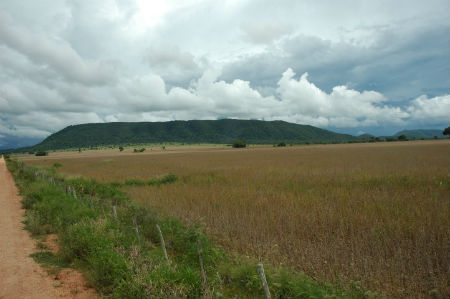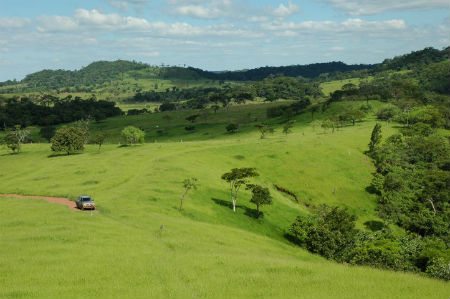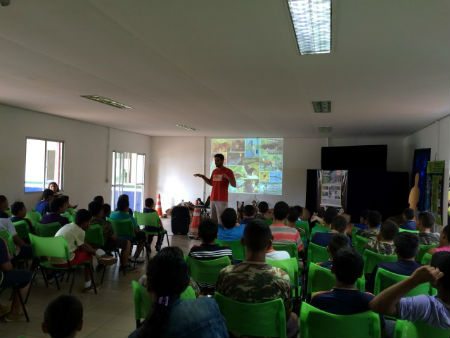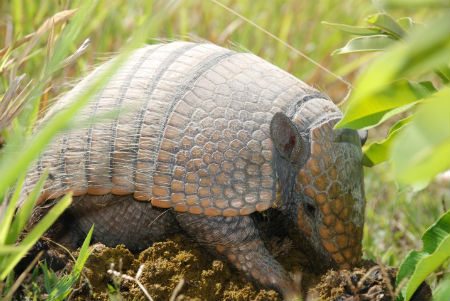Arnaud Desbiez gives us an update on what’s been happening at the other field site in the Cerrado:
“In contrast to the Pantanal update, the Cerrado giant armadillo work has been progressing, well. As the Cerrado site is more elevated than the Pantanal, water runs off into streams so the rain here was not as much of an issue. However, the truck did get stuck a few times and some areas were inaccessible.
“The main goal of the work in the Cerrado is to map the distribution of the last populations/individuals of giant armadillos in the Cerrado of Mato Grosso do Sul. To do this we have randomly sampled municipalities in which 15-20 watersheds with varying amounts of native vegetation are investigated for signs of giant armadillos. We also conduct interviews and have a Citizen Science program where people are invited to contribute any information on sightings of giant armadillos.
“The first expedition this year covered the municipality of Banderantes – giant armadillo evidence was located in some of the areas sampled. In this particular area giant armadillos were only present in lowlands while the higher areas where the soil is more compact and rocky they were not found. The population in this area was mostly composed of ranches.
“A second expedition covered the Bela Vista municipality. This area has become increasingly converted into large cash crop plantations mainly sugar cane, soy and corn. No giant armadillos were located and no calls were received from the Citizen Science posters. Fewer people in this area knew the giant armadillo existed although some of the more elderly people interviewed seem to remember this animal had existed. A member of the team gave several talks on the local radio speaking about the species in Bela Vista.
“The third expedition headed up North to the Santa Rita municipality were eucalyptus plantations are transforming the landscape. According to the Citizen Science posters giant armadillos are present in the area and the team found giant armadillo evidence in several locations. In general people were more aware of the species in this municipality.
“The fourth expedition headed out to Corguinho and also confirmed presence and absence of the species in several localities. The fifth expedition area had lots of natural vegetation but due to the rocky nature of the soil and mountainous characteristics of the area no evidence of giant armadillo was located. Interviews confirmed giant armadillos are not present anymore although it seems that they could have been present about 30 years ago. There is actually a mountain that was named after giant armadillos as an individual was sighted there 30 years ago.

“We only returned from the sixth expedition, which was to Porto Murtinho, a few days ago. This area is very interesting as a large part of it is has a protected area for three indigenous ethic groups. Overall the area is relatively well preserved and native vegetation still covers large areas. However no giant armadillo evidence was located. We conducted over 60 interviews and no one had seen a giant armadillo in the area. However on the edge of the municipality which is closer to the Pantanal it does appear that giant armadillos were present some 30-40 years ago. In this area many people did not know of the species.
“Work in the Cerrado is fascinating as we conduct many interviews with such a range of stakeholders ranging from landless people, small farmers or indigenous communities to large owners of cattle ranches and even multinational companies. We navigate between so many different worlds and realities. What is heart-breaking however, is that we really experience habitat loss and destruction first hand. Large areas have been and are being converted to cash crops or pasture. The landscapes are changing at such a rapid rate. The older generation is very much aware of all that is being lost and share many stories of how strikingly different things were just 30-40 years ago. I cannot help but think that there will be very little for my kids to see. I almost feel like pulling them out of school so they can experience all the sights and scenes we are still privileged to witness. This last expedition in the Cerrado really made me think of our diversity of perceptions and perspectives.

“Have you heard of the term shifting baselines? Or the one I prefer: generational amnesia? Both terms refer to a shift over time in the expectation of what a healthy ecosystem baseline looks like. There is a loss of perception of change that occurs when each generationredefines what is “natural”. In the interviews this becomes so real and each generation has their own baseline to what Nature should look like forgetting what the previous one experienced. What will be left for my children, what will their baseline be?
“I suppose the most striking example of change comes from the interviews in the indigenous communities. Elders shared stories from their childhood where their parents would travel to the Pantanal on hunting expeditions bringing back marsh deer meat and rhea eggs (as well as the odd giant armadillo). Their stories were enchanting although their lives so challenging. One man’s father lived off trading animal pelts. Today things could not be more different. The young generation is totally disconnected from the natural world. Instead of asking us questions about giant armadillos and our work they were eager to learn about the project through our facebook page and website.
“Another thought that ran through my head as we interviewed people in the Cerrado is how giant armadillos could so easily become a mythical creature from the past. In one of the areas the team and I had covered, almost no one had ever seen a giant armadillo. However it was wonderful to see that many had heard of the species through the media interviews and TV programs we participated in. It was nice to see that our outreach work is effective. However in their minds giant armadillos were even more giant! People waved their arms to say they made huge holes and then exaggerated their size to that of a horse. You can easily imagine this species becoming a legend rather than an animal we still have and desperately need to safeguard.

“Finally there are always many funny stories to be shared from the interviews. There is one that happened in the northern part of the state where giant armadillos can still be found. Even when present the species is incredibly rare. Two ranch workers saw a giant armadillo and were shocked when they saw it and thought no one would believe them when they told them what they had seen. So the guys decided to catch it and bring it back to the ranch. Both men struggled with the animal and put in the trunk of their car !!! Now if you have been following my updates you can easily guess what happened. Think of Houdini or Zezinho and what they did to the holding crate. That’s right in a matter of seconds the giant armadillo destroyed the trunk an appeared in the back seat of the car where it was immediately released. The whole back of the car was destroyed. No one needed to exaggerate in that story as I could easily imagine the damage done!

“Overall attitudes towards giant armadillos are one of amazement and wonder. People are sensitive to the fact that this is an incredible animal. So many people stated they wished they could see one. Looking at people’s faces when we show them a video of a giant armadillo really confirms that this species is an exceptional and perfect candidate as an ambassador for biodiversity conservation.”
Catch up on the armadillo story so far by reading the previous updates we’ve received from Arnaud and his team, here.